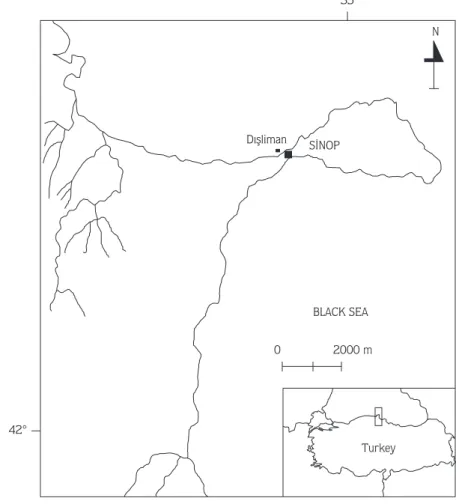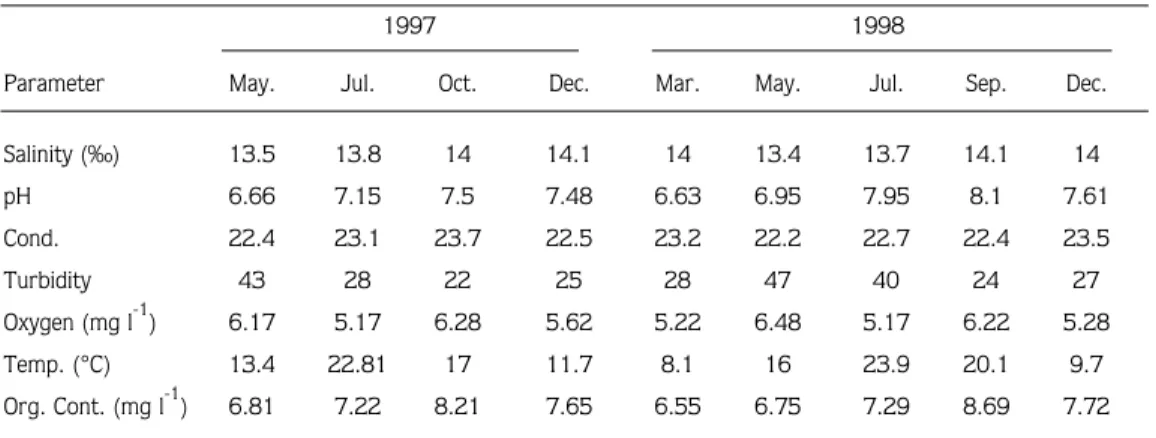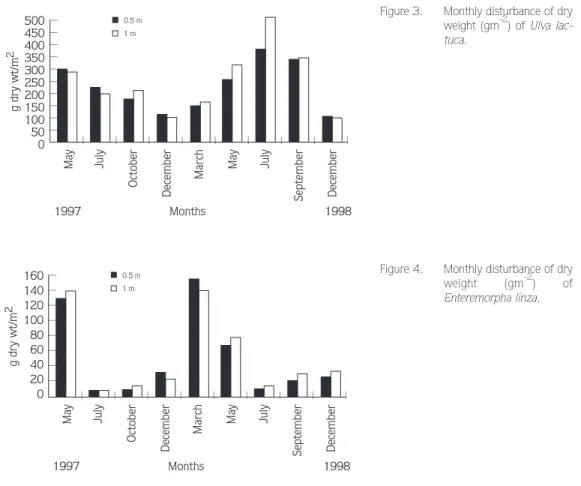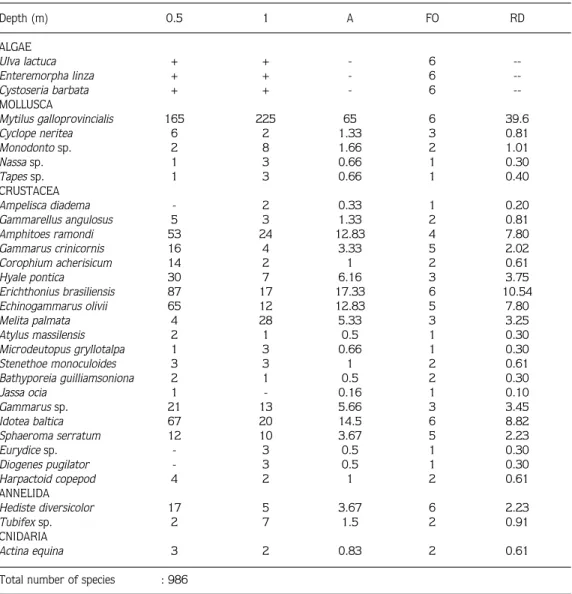Effects of Sewage Pollution the Structure of the
Community of Ulva lactuca, Enteremorpha linza
and Rocky Macrofauna in DÝßliman of Sinop
Levent BAT, Mehmet AKBULUT, Murat SEZGÜN, Mehmet ‚ULHA
University of Ondokuz MayÝs, Sinop Fisheries Faculty, Department of Basic Sciences, Sinop - TURKEY
Received: 30.06.1999
Abstract : Untreated sewage and domestic wastes from the Sinop outfall enter the DÝßliman region.
The effect of this on the distribution of Ulva lactuca, Enteromorpha linza and benthic macrofauna and on enviromental parameters was determined.
Increases in the growth of opportunistic green algae such as Ulva lactuca and Enteromorpha linza in response to increased nutrient supply in the DÝßliman coastal ecosystems in Sinop are reported in the present study.
The results of this study show that organic enrichment also increases, with Mytilus galloprovincialis (Mollusca), Erichthonius brasiliensis, Echinogammarus olivii and Amphitoes ramondi, Idotea baltica and Sphaeroma serratum (Crustacea) being the most abundant species.
Key Words: Organic content, Ulva lactuca, Enteromorpha linza, biomass, quadrat © T†BÜTAK
Introduction
During the past few decades, marine coastal areas all over the world have been exposed to many environmental hazards. The most potentially threatening of these have been the widespread use of various persistent pollutants and poisonous chlorinated compounds, heavy metals and residual nuclear wastes. However eutrophication, defined as an increase in nutrients leading to an increase in the growth of plants such as phytoplankton or opportunistic green
macroalgae such asUlva and Enteremorpha spp, is also now perceived as a serious threat (1-3).
It is now increasingly apparent that nutrient enrichment is about to cause or indeed has already brought about eutrophication on a permanent basis in some coastal waters and even in entire sea areas (1, 4-7). There are good reasons to believe that eutrophication will become a common problem in the future in many parts of the world with the consequence of potential damage to inshore fisheries and recreational facilities. Rapid urbanisation has increased nutrient input into coastal waters as well as increasing sewage production and the use of fertilizers (1,3,7).
Domestic waste is the greatest source of organic matter discharged into Turkish coastal waters. In many towns and cities situated on the coast, however, sewage is discharged untreated or with only primary treatment (removal of major solid matter). Organic matter is an important nutrient, as it is a source of food for many benthic invertebrates in the marine ecosystem. A small amount of domestic sewage, well dispersed, can be utilised within the ecosystem to enhance levels of production (2,3) because it enhances the quality and variety of food resources available for exploitation by those species with the reproductive potential to take advantage of them (4). Organic enrichment can therefore have a biostimulative effect which enhances benthic productivity without having any detrimental effects (1,5).
Sewage wastes are being dumped in many inshore areas (1-4). When these are discharged at a single point source or into a system with a low flushing rate, the volume of organic matter increases (3-5). Changes in the benthic community structure can be largely correlated with the extent of organic enrichment at sewage sludge dumping grounds (1,8). Temporal changes in an organically enriched environment show an initial increase in the numbers and biomass of almost all the benthic species present, as enrichment of the substrate with organic material increases. This is followed by a phase in which the more sensitive species in the benthic community disappear while those that remain reach maximum biomass and abundance. In the later stages of the process, the number of benthic macrofaunal species present is greatly reduced. Finally, a stage is reached where no macrofaunal species can survive (1).
Anthropogenic nutrient inputs into the DÝßliman area of Sinop have increased rapidly in recent years with enhanced inputs of sewage effluent (9). Sinop sewage works discharge untreated sewage off the coast of DÝßliman. The effects of this increase in nutrients in the DÝßliman area is noticeable in the increase of opportunistic mat-forming macroalgae, including such species as Ulva lactuca and Enteremorpha linza.
The sewer outfall at DÝßliman has a local effect on the intertidal macrofaunal community and is not severe enough to cause the absence of all but the most tolerant species. This study, therefore, looked at the abundance and distribution of the macrofauna in relation to the effects of organic enrichment and the presence of Ulva lactuca and Enteremorpha linza (the growth of these species is stimulated by the enrichment processes) along the main sewage pollution gradient of the outfall on the coast of Sinop.
Study Area
The DÝßliman outfall in Sinop was selected in order to gain an understanding of the effects of domestic sewage on marine ecosystems. The sewage discharge consists primarily of untreated human wastes and domestic wastes. The outfall has been in operation for over 20 years and discharges into the DÝßliman area of Sinop. This intertidal region is relatively uniform in character, consisting of a rocky substrate composed of large and numerous rocks (Figure 1). Macrofauna in DÝßliman in Sinop
Figure 1. Sampling station BLACK SEA DÝßliman SÜNOP 35¡ N 0 2000 m 42¡ Turkey
Materials and Methods
The distributions and abundances of macrofauna were determined with reference to depths of 0.5 and 1 m from the outfall. The outfall region was sampled in the period May 1997 -December 1998, particularly in the sewage-affected area. Consequently, data collected from all nine sampling sites and periods were considered to be representative and were grouped. At the
outfall, two samples were taken using a quadrat of 20X20 cm2, at depths of 0.5 and 1 m. An
area of 400 cm2has been suggested as being representative of a community structure (10). In
Macrofauna in DÝßliman in Sinop
Samples of the community ofUlva lactuca and Enteremorpha linza were collected from each
quadrat and washed thorougly. These samples from each quadrat were placed overnight to dry using a dry paper. The samples were then weighed and dried to a constant weight at 105¡C for 24 hours. The biomass of Ulva lactuca and Enteremorpha linza were expressed in terms of the dry weight.
The quadrats were transferred to labelled plastic bags and washed over a 0.5 mm mesh to remove the sediment and particles. The macrofauna retained were transferred to labelled plastic jars and fixed with 10% formalin in filtered seawater (10). For health and safety reasons, each sample was later washed again and the formalin replaced with 70% ethanol before sorting. Sorting was done using a binocular dissecting microscope (x10 to x40 magnification) and all the animals were identified to species level when possible (2,3,6,7). Two quadrats from each depth were sorted and the means of these two counts were used in the subsequent analysis (11).
Comparisons between sites (0.5 and 1 m depths) were carried out using detrended correspondence analysis and basic reciprocal averaging techniques and SimpsonÕs index of diversity, the Shannon diversity index, PielouÕs evenness index, and the Simpson and Margalef species richness indices.
Estimates of sediment organic content were derived from the per cent weight loss on ignition of the dry sediment at 600¡C for 4 hours (12).
Results and Discussion
The sediment consisted of muddy sand mixed with terrigenous gravel particles. However the average organic content value for the top 5 cm was 2.0%, 2.1%, 1.6%, 1.2%, 0.5% and 0.4% at the depths of 0.5m (near the outfall), 1m (near the outfall), 3 m (25 meters away from the coast line), 5 m (50 meters away from the coast line), 5.5 m (250 meters away from the coast line) and 8.5 m (400 meters away from the coast line), respectively (Figure 2). These differences were statistically significant (Table 1). Figure 2 also shows that the organic content decreased with an increase in the distance from the outfall.
Table 1. One way ANOVA (Analysis of variance) of organic matter of sediments.
Source df SS MS F P Depths (m)
Depth 5 6.3188 1.2638 122 0.001 0.5 1.0 3.0 5.0 5.5 8.5
Error 12 0.1242 0.0104
Total 17 6.4430
Some physico-chemical parameters of the sea water were measured during the sampling period. These values are listed in Table 2.
The community of Ulva lactuca and Enteremorpha linza displayed seasonal variations. The highest level of Ulva biomass was observed in summer, corresponding to the development of Ulva lactuca, and a secondary peak was observed in spring, corresponding to the maximum development of the basal stratum. The lowest value was recorded in winter. Ulva growth began in spring with peak biomass occurring in July followed by a decline in autumn (Figure 3),
whereas Enteremorpha increased in terms of weight in March and May (Figure 4). This increase
in plant fragments could be related to water velocity in areas where it is lowest, due to a high concentration of macroalgae.
Increases in the growth of macroalgae seem to be positively correlated with the increases in nutrient inputs. Initially, nutrient enrichment increased the overall productivity of DÝßliman but under dense algal mats, the substratum became anoxic, invariably affecting the abundance of the invertebrates and hence their predators.
Table 2. Physico-chemical parameters of sea water.
1997 1998
Parameter May. Jul. Oct. Dec. Mar. May. Jul. Sep. Dec.
Salinity (ä) 13.5 13.8 14 14.1 14 13.4 13.7 14.1 14 pH 6.66 7.15 7.5 7.48 6.63 6.95 7.95 8.1 7.61 Cond. 22.4 23.1 23.7 22.5 23.2 22.2 22.7 22.4 23.5 Turbidity 43 28 22 25 28 47 40 24 27 Oxygen (mg l-1) 6.17 5.17 6.28 5.62 5.22 6.48 5.17 6.22 5.28 Temp. (¡C) 13.4 22.81 17 11.7 8.1 16 23.9 20.1 9.7 Org. Cont. (mg l-1) 6.81 7.22 8.21 7.65 6.55 6.75 7.29 8.69 7.72 Ñ Ñ Ñ Ñ Ñ Ñ Ñ Ñ Ñ Ñ Ñ 2.5 2 1.5 1 0.5 0 0.5 1 3 5 5.5 8.5 Dephts (m) Organic content (%)
Figure 2. Percentage of organic con-tent at DÝßliman station. Each value shows the mean of three replicates. (error bars = SE).
Macrofauna in DÝßliman in Sinop
The increased sewage pollution in late spring and summer from the population of Sinop was reflected in changes in the species composition of Ulva and in an increase in biomass and production. These changes were not extreme, but this species benefitted from the constant nutrient effluent of DÝßliman.
However, it is clear that organic pollution acts as a physical stress in Ulva and Enteremorpha communities, changing their biomass (Figures 3 and 4) and species composition.
Arthropoda were the most abundant group, comprising 71.% of the total biomass. Mollusca the next largest group, making up 17.86% of the total biomass. Annelids and Cnidaria comprised 7.14% and 3.57% of the total biomass, respectively (Table 3).
The relationship between species abundance and diversity has been discussed at length by Pearson and Rosenberg (1). They concluded that along a gradient of organic pollution, there is a point where the community becomes dominated by large numbers of a few opportunistic
Ñ Ñ Ñ Ñ Ñ Ñ Ñ Ñ Ñ Ñ Ñ Ñ Ñ Ñ Ñ Ñ Ñ 160 140 120 100 80 60 40 20 0 May 0.5 m 1 m g dry wt/m 2 July October December March May July September December 1997 Months 1998
Figure 4. Monthly disturbance of dry weight (gm-2) of Enteremorpha linza. Ñ Ñ Ñ Ñ Ñ Ñ Ñ Ñ Ñ Ñ Ñ Ñ Ñ Ñ Ñ Ñ Ñ Ñ Ñ 500 450 400 350 300 250 200 150 100 50 0 May g dry wt/m 2 July October December March May July September December 1997 Months 1998 0.5 m 1 m
Figure 3. Monthly disturbance of dry weight (gm-2) of Ulva lac-tuca.
species. In areas closer to the source of pollution, there will be fewer species of macrofauna as many species are unable to tolerate the high organic-loading sediment. In areas more distant from the source of pollution, there are more species of macrofauna present in lower abundance as the community returns to the undisturbed state where diversity remains high due to competition (1,8,13,14).
The results of the present study appear to support those of Pearson and Rosenberg (1). Species abundance was highest directly opposite the sewage outfall with corresponding low diversity (Table 4). The reason for this may be that the level of organic input was not high enough to have a detrimental effect on all of the species present, being sufficient only to promote the increase in abundance of the opportunistic species.
The use of biomonitor species has often been put forward as a useful method of assessing the effects of environmental disturbance (1,8,14). A biomonitor species thrives only under particular environmental conditions and therefore is an indicator of the conditions in which it is found (14-16). The most often used biomonitor organisms are opportunistic and are tolerant to high levels of stress. These species seem to have several characteristics in common: (a) they live in a protected habitat in the sediment layer either in mucus tubes or without any specialized cover (ie. molluscs), (b) they are able to utilize food, the organic detritus and bacteria which are plentiful due to the effect of the sewage outfall, (c) the species are euryhaline, so they are able to survive sudden environmental changes in the sediment or on the rocks, and (d) they can tolerate low oxygen levels and a certain amount of hydrogen sulphide for long periods of time. In the present study, the diverse and abundant benthic biomass of DÝßliman in Sinop results from the eutrophic and organically rich water flowing above the benthos. Of the Mollusca, the filter-feeding Mytilus galloprovincialis was found to be the most dominant species, forming 39.6% of the total biomass. They can utilize the kind of food contributed by the sewer outfalls. Mytilus galloprovincialis was attached to the basal stratum or to the holdfasts of Ulva lactuca. Of the Crustacea, Amphitoes ramondi, Erichthonius brasiliensis, Echinogammarus olivii, Idotea baltica and Hyale pontica occurred in increased numbers (Table 4). This would suggest that these species respond in the same way to the same environmental parameters.
Systematic groups Number of species Dominance (%)
Mollusca 5 17.86
Arthropoda 20 71.43
Cnidaria 1 3.57
Annelida 2 7.14
Total 28 100
Table 3. Number of species and dominance (%) for each systematic group
Macrofauna in DÝßliman in Sinop
The Annelids Hediste diversicolor and Tubifex sp. are often-quoted biomonitor species (1). They are poor competitors, but have a highly opportunistic lifestyle, so they are able to colonize moderately polluted areas where dominant competing species cannot survive. In the present study, Hediste diversicolor and Tubifex sp. increased in abundance under algal mats in the DÝßliman area, due to the organic enrichment occurring there (Table 4).
Table 4. Variations in species number of macrobenthic fauna at different depths and abundance (A), the frequency of occurrence (FO), relative dominance (RD).
Depth (m) 0.5 1 A FO RD ALGAE Ulva lactuca + + - 6 --Enteremorpha linza + + - 6 --Cystoseria barbata + + - 6 --MOLLUSCA Mytilus galloprovincialis 165 225 65 6 39.6 Cyclope neritea 6 2 1.33 3 0.81 Monodonto sp. 2 8 1.66 2 1.01 Nassa sp. 1 3 0.66 1 0.30 Tapes sp. 1 3 0.66 1 0.40 CRUSTACEA Ampelisca diadema - 2 0.33 1 0.20 Gammarellus angulosus 5 3 1.33 2 0.81 Amphitoes ramondi 53 24 12.83 4 7.80 Gammarus crinicornis 16 4 3.33 5 2.02 Corophium acherisicum 14 2 1 2 0.61 Hyale pontica 30 7 6.16 3 3.75 Erichthonius brasiliensis 87 17 17.33 6 10.54 Echinogammarus olivii 65 12 12.83 5 7.80 Melita palmata 4 28 5.33 3 3.25 Atylus massilensis 2 1 0.5 1 0.30 Microdeutopus gryllotalpa 1 3 0.66 1 0.30 Stenethoe monoculoides 3 3 1 2 0.61 Bathyporeia guilliamsoniona 2 1 0.5 2 0.30 Jassa ocia 1 - 0.16 1 0.10 Gammarus sp. 21 13 5.66 3 3.45 Idotea baltica 67 20 14.5 6 8.82 Sphaeroma serratum 12 10 3.67 5 2.23 Eurydice sp. - 3 0.5 1 0.30 Diogenes pugilator - 3 0.5 1 0.30 Harpactoid copepod 4 2 1 2 0.61 ANNELIDA Hediste diversicolor 17 5 3.67 6 2.23 Tubifex sp. 2 7 1.5 2 0.91 CNIDARIA Actina equina 3 2 0.83 2 0.61
The results showed that the greatest species richness was higher at a depth of 1 m than at a depth of 0.5 m, whereas, species diversity was low at the depth of 1 m when compared to the depth of 0.5 m. The level of dominance at 1 m (54.5) was higher than at 0.5 m (28.8)
(Table 5). The Shannon diversity (HÝ), Margelef species richness indices (d) and PielouÕs
evenness (JÝ), are also indicated in Table 5. The HÝvalues 2.284 and 1.980 were obtained at
depths of 0.5 and 1 m, respectively. The greatest d value was computed to be 3.622 at 0.5 m, where 573 species were found, and 4.316 at 1 m, where 413 species were found. PielouÕs index (evenness) was 0.719 at 0.5 m and 6.01 at 1 m, indicating that depth was a very important component in the distribution of the macrofauna.
JaccardÕs similarity coefficient was computed to be 82% between the depths of 0.5 m and 1m. It may be suggested that the similarity between the sampling depths was high.
Conclusion
Most of the patterns mentioned above have been documented in offshore areas but there have been relatively few gradient studies of organic pollution in shallow water areas. Mutlu (17) showed that the species number was higher in the shallow-water than in the deep waters of the Black Sea. The present study was carried out in shallow waters and we investigated the changes in macrofauna community structure along an organic enrichment gradient in DÝßliman caused by sewer outfall in Sinop, focusing on the infra-littoral zone. No previous investigation has been carried out at this site.
Acknowledgement
We would like to thank Anne-Catherine Muriel BAT for correcting the English of this paper.
References
1. Pearson, T.H., Rosenberg, R., Macrobenthic succession in relation to organic enrichment and pollution of the marine environment. Oceanogr. Mar. Biol. Ann. Rev., 16: 229-311, 1978.
Table 5. Number of species (S), diversity of species (D), dominance, Shannon diversity, PielouÕs evenness, Simpson and Margelef species richness indices at different depths.
Depth S D Dominance Shannon Pielou Simpson Margaref
0.5 m 573 24 28.8 2.284 0.719 0.872 3.622
2. Raffaelli, D., Hull, S., Milne, H., Long-term changes in nutrients, weed mats and shorebirds in an estuarine sys-tem. Cah. Biol. Mar., 30: 259-270, 1989.
3. Raffaelli, D., Limia, J., Hull, S., Pont, S., Interactions between the amphipod Corophium volutator and macroalgal mats on estuarine mudflats. J. mar. biol. Ass.UK.,71:899-908, 1991.
4. Tulkki, P., Effect of pollution on the benthos off Gothenburg. HelgolŠnder Meeresunters, 17: 209-215, 1968. 5. O'Sullivan, A.J., Ecological effects of sewage discharge in the marine environment. Proc. Roy. Soc. Lond., 177(B):
331-351, 1971.
6. Kydd, A.M., The effects of organic pollution from the Newburgh sewage outfall on invertebrate communities. Honours Project, University of Aberdeen, Scotland, 1985.
7. Trevetick, L., The effects of organic pollution from Newburgh sewer outfall on the intertidal macrofauna of the Ythan mudflats. Honours Project, University of Aberdeen, Scotland, 1991.
8. Bat, L., Raffaelli, D., Survival and growth of Corophium volutator in organically enriched sediment : A compari-son of laboratory and field experiments. Tr. J. Zoology, 22 (3): 219-229, 1998.
9. Bat, L., …ztŸrk, M., Heavy Metal Levels in Some Organisms from Sinop Peninsula of the Black Sea. Tr. J. Engineering and Environ. Sci., 21: 29-33, 1997.
10. Kocataß, A., Üzmir Kšrfezi kayalÝk sahillerinin bentik formlarÝ Ÿzerinde kalitatif ve kantitatif araßtÝrmalar. Ege †niver-sitesi, Fen FakŸltesi Monografileri Serisi No: 12, Ege †niversitesi MatbaasÝ, Bornova, Üzmir, 1978.
11. Zar, J.H. , Biostatistical analysis. 2ndEd., Prentice Hall, Int., New Jersey, p.718, 1984.
12. Buchanan, J.B., Methods for the Study of Marine Benthos. Sediment analysis. In: N.A. Holme and A.D. McIntyre (Eds.), Blackwell Sci. Publ., p. 41-65, 1984.
13. Limia, J.M., Bioturbation of intertidal sediments: An experimental approach involving the amphipod Corophium volutator (Pallas), Ph.D. Dissertation, University of Aberdeen, Scotland, 1989.
14. Bat, L., Raffaelli, D., Sediment toxicity testing: A bioassay approach using the amphipod Corophium volutator and the polychaete Arenicola marina. J. exp. mar. Biol. Ecol., 226: 217-239, 1998.
15. Morrisey, D.J., Underwood, A.J., Howitt, L., Effects of copper on the faunas of marine soft-sediments: an exper-imental field study. Mar. Biol., 125: 199-213, 1996.
16. Lenihan, H.S., Kiest, K.A., Conlan, K.E., Slattery, P.N., Konar, B.H., Oliver, J.S., Patterns of survival and behav-ior in Antarctic benthic invertebrates exposed to contaminated sediments: field and laboratory bioassay experi-ments. J. Exp. Mar. Biol. Ecol., 192: 233-255, 1995.
17. Mutlu, E. A., preliminary study on macrobenthic mollusc and crustaceans along the Anatolian coast of the Black Sea. M.Sc. Middle East Technical University, Institute of Marine Sciences, 178 p., 1990.





